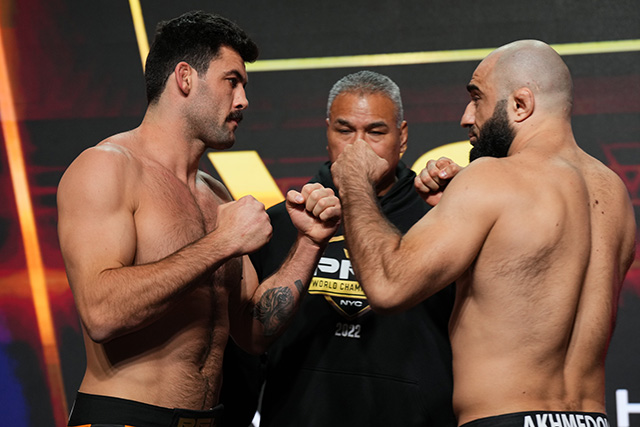When Rob Wilkinson was released by the Ultimate Fighting Championship in 2018 after back-to-back losses to Siyar Bahadurzada and Israel Adesanya, the MMA world collectively shrugged. A Reddit topic from the time had relatively few upvotes and responses, many of them focusing more on Wilkinson’s nickname than his actual fighting skills. Who could blame them? Wilkinson was 26 years old and appeared to be a decent but unexceptional middleweight. He was a fairly good grappler with average standup, some significant defensive holes and suspect cardio. There were dozens of fighters just like him.
No one was aware such a transformation had taken place entering 2022, Heading into the year, a post-UFC Wilkinson had scored two wins—one in 2019 and another in 2021—over lower-level opponents and enjoyed a few successful excursions into kickboxing and boxing. His status had gone largely unchanged since 2018, and he signed with the Professional Fighters League to little fanfare.
Then came Wilkinson’s brutal second-round technical knockout of talented Brazilian striker Bruce Souto at PFL 1 on April 20. Several qualities were immediately obvious about this new version of Wilkinson. First, the former middleweight was now an enormous light heavyweight, carrying great size at 6-foot-3 along with an 80-inch reach. Second, his cardio looked much improved. Wilkinson finished Souto in the second round—a time in which he already would have slowed down during his UFC run. Third and perhaps most importantly, Wilkinson had shifted from being primarily a grappler to a striker, charging forward with punches in bunches, especially his money shot: a deadly right cross. He also delivered an overwhelming helping of knees to any opponent who dared to clinch with him.
Wilkinson proved the performance was no fluke in his next two PFL appearances, as he put away Viktor Pesta with first-round punches in his regular-season finale and then cut down Delan Monte with a devastating knee in the light heavyweight semifinals of the Professional Fighters League playoffs. Neither man knew what hit him. Wilkinson eschewed any sort of feeling-out process and simply drowned them with powerful strikes.
Yet for all his dominance, there were still doubts surrounding Wilkinson as he prepared for his light heavyweight tournament final with Omari Akhmedov on Nov. 25, a $1 million payday on the line. Akhmedov was once a Top 10 middleweight in the UFC and had impressed in his run to the final. He had gone 3-0 with two finishes and a dominant decision over the previously unbeaten Joshua Silveira. Akhmedov’s striking was more technical than it had been in the UFC, plus his defense was better than ever and his conditioning woes appeared to have been addressed, allowing him to comfortably go 15 minutes against Silveira with energy to spare. I thought Akhmedov was a live underdog.
Wilkinson sure proved me wrong. Quite incredibly, the Australian had sharpened his striking even more in the three and a half months since his PFL semifinal. There was sturdier defense and a fine use of feints. He battered Akhmedov with punches and expertly used the uppercut whenever the Dagestani tried to wrestle with him. Wilkinson likely would have knocked out Akhmedov at the end of the second round had he been given a few more seconds with which to work. As it was, the cageside physician advised a merciful stoppage between rounds due to a cut. It served as a perfect capstone to Wilkinson’s turnaround. He was indeed an elite light heavyweight who inspired fear at 205 pounds.
Sherdog contributor Keith Shillan, a driving force behind Wilkinson’s nomination as “Comeback Fighter of the Year,” put it this way: “If you had told me a year ago that Rob Wilkinson would become the champion of a major organization and wreck everyone he faced while doing so, I would have laughed at you.” No one is laughing anymore, except for maybe Rob Wilkinson himself.



